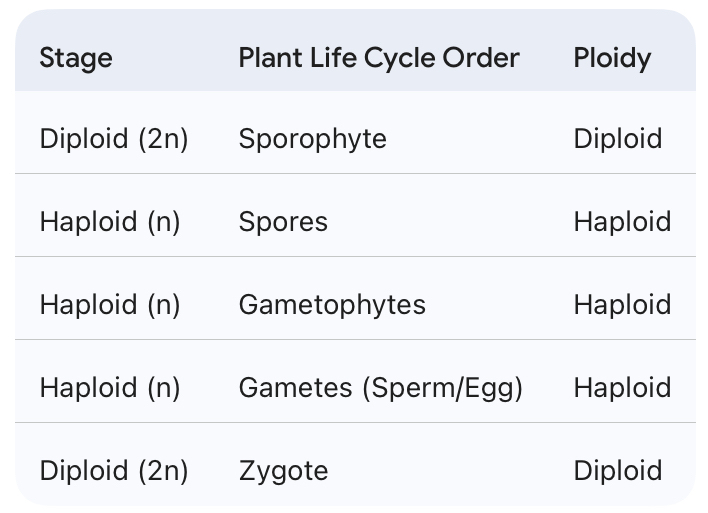Plant diversity 1
1. What separates plants from other Eukaryotes? What traits do most plants have in common?
• Separating Trait: Plants must carry out all aspects of life without moving; they are stationary. This has led to many adaptations.
• Common Traits:
• They belong to the Domain Eukarya and Kingdom Plantae.
• They are multicellular organisms that use photosynthesis (implied by content on carbon dioxide and need for light/water).
2. Describe challenges that plants faced as the ancestors of land plants transitioned to life on land.
The ancestors of land plants, which lived in water, faced two main challenges when moving to a terrestrial environment:
1. Preventing Dehydration (Desiccation).
2. Withstanding the Pull of Gravity.
3. How did early plants cope with the challenges of life on land - what adaptations did they have?
Early plants developed the following key adaptations:
• To prevent dehydration: They developed an outer waxy layer called a cuticle that covers their entire surface.
• To cope with gravity: The earliest plants grew very close to the ground to resist the pull of gravity, much like mosses do today.
Non-vascular plants (Mosses and others)
4. Why do non-vascular plants tend to be small & low to the ground? Why do they tend to live only in moist environments?
• Small & Low to the Ground: They grow small and close to the ground because extensive support or vascular structures are not needed.
• Moist Environments: They require wet or moist environments because:
1. They lack vascular tissue and are unable to transport and store water efficiently.
2. They have very short root-like projections (cannot reach deep into the soil for water/nutrients).
3. They require water to transport their sperm for reproduction.
5. How do non-vascular plants move materials within their bodies?
• Materials are moved within the plant via diffusion.
6. What 3 groups of plants are included in "non vascular" plants?
1. Hornworts
2. Liverworts
3. Mosses
7. Draw the life cycle of an animal and plant and label each stage - how does the life cycle of plants differ from that of animals? Which stages of the life cycle are diploid? Which are haploid?Difference from Animals: All plants exhibit two distinct multicellular generations (Sporophyte and Gametophyte) within their lifecycle, known as the Alternation of Generations. \

8. In non-vascular plants - which stage of the life cycle is dominant? What does the sporophyte look like?
• Dominant Stage: The Gametophyte generation is dominant in non-vascular plants (mosses). Dominant means it is bigger, lives longer, and can live on its own.
• Sporophyte Appearance: The sporophyte is the diploid form, which grows as a stalk with a spore capsule on top, dependent on the main haploid moss plant.
9. How do non-vascular plants transport their sperm? How are their spores transported?
• Sperm Transport: They require water to transport their sperm (they have swimming sperm).
• Spore Transport: The spores are typically released into the air from the sporophyte capsule and are transported by the wind (implied by the life cycle).
10. What is a peat bog & how is a peat bog formed? Why are peat bogs so ecologically important? What are some human uses of peat?
• Peat Bog: A habitat containing decomposed Sphagnum moss in water-logged conditions.
• Formation: The bogs contain very little oxygen and few microbes, causing decomposition to happen extremely slowly. Dead plants accumulate over time in layers, forming peat.
• Ecological Importance: They store vast amounts of carbon, accumulating twice as much carbon as all forests combined across 3% of the world's surface, because the carbon from dead plants is not quickly broken down and returned to the atmosphere.
• Human Uses of Peat:
• Used for fuel (can be dried and burned to heat homes).
• Used as a soil addition (e.g., sphagnum moss).
• Used as an ingredient in Scotch (whisky), where the burning peat during distillation provides a smoky flavor.
Seedless Vascular plants (Ferns and others)
11. Why was the evolution of vascular tissue an important evolutionary "step" for plants? What did it allow them to do?
• Vascular tissue (Xylem and Phloem) was important because it provided the role of transportation and storage of water, nutrients, and sugar.
• This adaptation allowed plants to:
• Grow bigger (can move materials around more efficiently).
• Become slightly less dependent on a constant source of water (due to storage).
• Develop deeper root tissue, allowing them to extend further into the soil.
12. Which stage is dominant in the life cycle of seedless vascular plants (ferns)?
• The Sporophyte stage is dominant in the life cycle of seedless vascular plants (ferns).
13. What are sporangia and where can you find them? How are fern sperm transported? How are fern spores transported?
• Sporangia: These are spore-producing bodies. They are found on the leaves (fronds) of the diploid fern (sporophyte).
• Fern Sperm Transport: Ferns still rely on water for reproduction because they have swimming sperm.
• Fern Spore Transport: Spores are released by the adult fern and are carried by the wind to a new location.